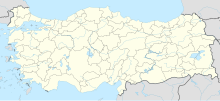Antandros
Coordinates: 39 ° 34 ' N , 26 ° 47' E
Antandros ( Greek Ἄμτανδρος ) was an ancient Greek city in Asia Minor landscape Troas in Turkey today. The town was located two kilometers east of the present-day town of Altınoluk on a settlement area on the coast of Adramyttion Bay, only a few hectares due to the topography of the area, and was settled by Aeolians .
Antandros was one of the cities that were already important in the time of the Trojan War . Under Darius I , Antandros belonged to the Persian Empire and later temporarily to the Attic League . During the Peloponnesian War , the rule of Antandros changed several times. Contemporary sources report that the art of shipbuilding was in full bloom in this city, according to which the shipyard supplied all Greek seaside cities with high-quality ships and, for economic reasons, maintained a strict policy of neutrality ; ships from hostile Greek cities were often lying next to each other in the shipyard on Kiel.
In Roman times, the city was part of the province of Asia and shaped from the late first ( Titus ) to the early 3rd century AD ( Elagabal ) - as in the 4th century BC. BC - own coins.
Probably as a result of earthquakes, the city was abandoned in Byzantine times and used as a quarry by the surrounding communities; no visible structures have been preserved in the area. The late antique bishopric of the city continues as the titular bishopric of Antandrus of the Roman Catholic Church.
exploration
When the German cartographer Heinrich Kiepert was traveling in the Ottoman Empire for his map of Asia Minor in the middle of the 19th century, he discovered a Greek inscription in the village of Avcilar in 1842 that drew his attention to Antadros. In 1888 Kiepert climbed Kaletaşı Tepesi (then Derbent Tepesi) together with Ernst Fabricius , where he came across ceramic shards and settlement remains. In 1881 Heinrich Schliemann became aware of Antandros through coin finds and examined the place. Walther Judeich later concluded that the settlement could be divided into an upper and a lower town and was probably not that big.
The archaeological investigation of the city's history has focused since the 1950s on the excavation of grave structures. The sites ( necropolis ) discovered near the outskirts of Altınoluk during the expansion of the Çanakkale – Edremit coastal highway were explored from 1989 to 1995, and around 2000 prompted a regional group of historians, artists and students to found an association to research the historical heritage of the city of Antandros. As early as 2001, in the course of the site survey carried out with the most modern methods and equipment, 19 Roman villas were discovered in the urban landscape and an area of 1,100 m² was examined during the first excavation; a mosaic floor could also be exposed. Remnants of a city wall were also found. The city's necropolis is 400 meters west and has tombs from the 7th century BC. Probably even older graves cannot be precisely dated. From 2001 to 2010, several dozen graves were examined, showing that the cemetery dates from the 7th century BC. Was used consistently until the classical Hellenistic period. There are only a few tombs from the Roman or Byzantine period.
The excavations take place under the direction of Prof. Dr. Gürcan Polat from Ege Üniversitesi in Izmir .
literature
- Gustav Hirschfeld : Antandros 1 . In: Paulys Realencyclopadie der classischen Antiquity Science (RE). Volume I, 2, Stuttgart 1894, Col. 2346.
- Elmar Schwertheim : Antandros [2]. In: The New Pauly (DNP). Volume 1, Metzler, Stuttgart 1996, ISBN 3-476-01471-1 , column 724.
- Walther Sontheimer: Antandros. In: The Little Pauly (KlP). Volume 1, Stuttgart 1964, Col. 167.
Web links
- The Antandros Project (Turkish)
- Coins of Antandros (English)

